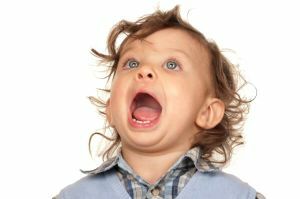 The bite of the teeth is their relative position with the jaws closed. Anomalies of the occlusion are observed if the teeth are misplaced or if the jaw formation is disturbed. The formation of the occlusion is influenced by a group of muscles located directly in the jaw region.
The bite of the teeth is their relative position with the jaws closed. Anomalies of the occlusion are observed if the teeth are misplaced or if the jaw formation is disturbed. The formation of the occlusion is influenced by a group of muscles located directly in the jaw region.
Deviations from the correct location of the teeth occur both in children during the growth period and in adults as a result of the injury.
An incorrect bite can significantly affect the quality of life. He creates problems with chewing food, diction, negatively affects the psychoemotional state.
Contents
- What is myogymnia and its role in orthodontics
- Basic principles and rules
- Advantages and disadvantages
- Exercises for
- muscles Exercise muscles that push the lower jaw
- Exercise the circular muscle of the mouth
- Exercises to correct various types of occlusion
- How to improve efficiency and effectivenessfrom exercises
- Practical experience of application of
What is myogymnia and its role in orthodontics
Myogymnia - methods for correction of occlusion and prevention of toothstnyh anomalies by performing a special set of physical exercises.
As early as the beginning of the last century, A. Rogers laid the foundation for myoterapy, proving the effectiveness of active treatment of muscles to eliminate dentoalveolar anomalies.
He also developed the first set of exercises for activating the functions of the maxillofacial muscles. Modified and supplemented complexes became the basis for modern methods of eliminating congenital and acquired bite defects. Half a century of research has proven the effectiveness of myotherapy in correcting abnormal occlusion.
Training of the muscles of the oral cavity surrounding the dentition, help restore their functions, improve the appearance of the dentition, prevent the development of unwanted processes.
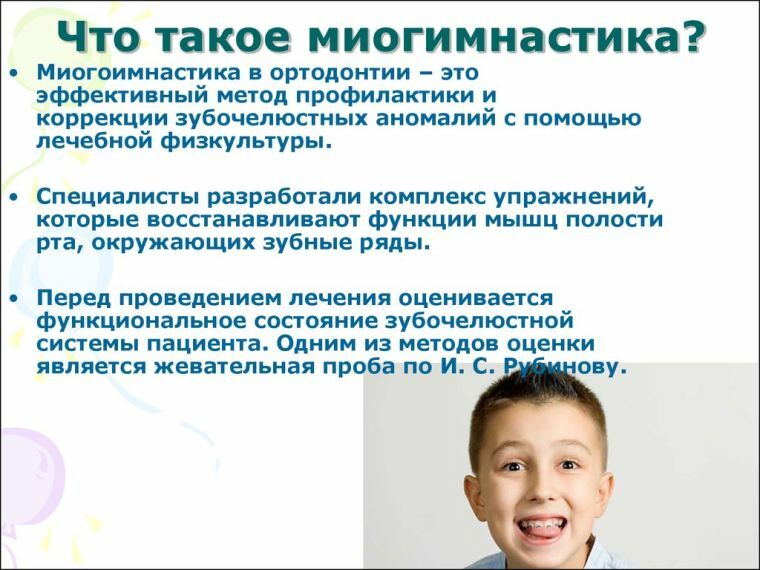
Myogymnia is used in orthodontics in various ways:
- physical exercises are prescribed as an independent type of treatment;
- as a preparatory stage before the beginning of orthodontic treatment;
- as a complementary component in conjunction with other procedures.
- as the fixing stage after the treatment to avoid relapse.
Depending on the specifics of defective changes in the dentition, the shape and size of the jaw, the nature of the interaction of the teeth when jaws are joined, several types of anomalies are distinguished, each of which requires a certain approach to correction.
For the correction of dentoalveolar anomalies specialists developed a set of special exercises. Classes can be held either with the help of special orthodontic equipment( equilibrator, vestibular plate, Friel disc, activator and other devices), and without them.
BASIC PRINCIPLES AND RULES
The basic principles for performing the exercises are:
- systematic - long breaks between sessions are not allowed;
- sequence - only after mastering simple exercises it is allowed to proceed to complex ones;
- Consciousness - An awareness of exactly what it is necessary to perform each exercise, dramatically increases the effectiveness;
- activity of ;
- an individual approach to the .
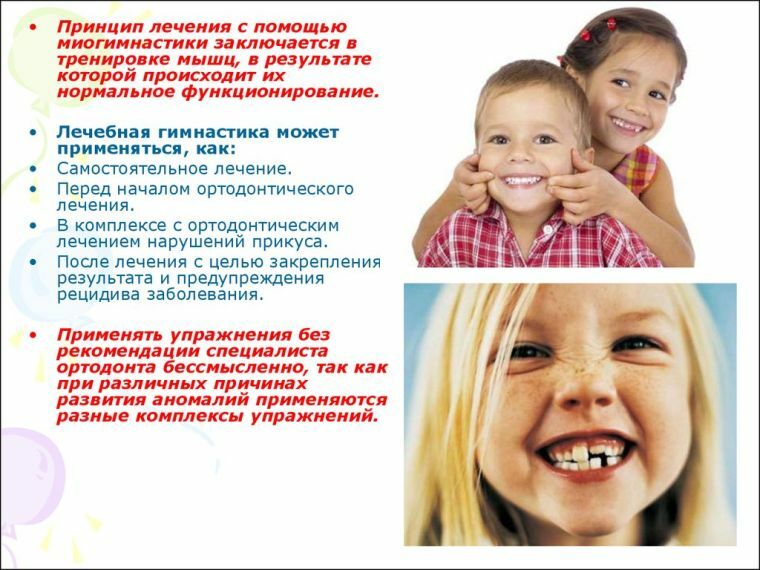
With the children classes are held:
- individually - a parent or other adult at home helps the child to perform the exercises;
- in group classes are held simultaneously for several people, and guidance and supervision of the correctness of technical performance is entrusted to the teacher or teacher.
Advantages and disadvantages of
The result of the exercises are:
- restoration of functional activity of the muscles of the mouth and tongue;
- normalization of the tonus of the musculature of the face;
- effective functioning of the tissues of the lower part of the face;
- restoration of normal operation of the muscles controlling the movement of the lower jaw.
The disadvantages of using myogym in orthodontics include:
- the complexity of controlling the correctness and duration of studies;
- not all forms of anomalies are amenable to correction with the help of this technique.
Contraindications include a number of factors:
- limitation of mobility in the temporomandibular joints;
- pronounced hypertrophy of facial muscles;
- bite anomalies, formed against a background of improper growth of the jaws.
Exercises for the muscles of the tongue
With infantile swallowing:
- The tip of the tongue is lifted to the palate and can stand for a few seconds in a posture.
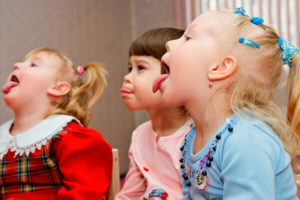
- Put a rubber ring on the tip of the tongue and press it against the alveoli of the teeth. Swallow 10-12 times, checking the presence of the ringlet at the right place.
- The tongue with the ring applied to it should be pressed against the alveoli for several minutes with the mouth closed tightly closed. The first time for the exercise is 5 minutes, but from day to day we extend the procedure to 15 minutes.
Exercise the muscles of the tongue in the middle part:
- tongue clamps 50-60 times;
- tongue with rubber bands on it( tip and middle part) is pressed to the palate, holding for a few seconds.
The muscles of the back part relax well with the help of yawning, as well as rinsing the mouth with warm water.
We train the muscles that push the lower jaw
The following actions should be performed:
- The lower jaw moves forward until the upper teeth of the upper row completely overlap. Delay the movement for 10 seconds.
- The previous exercise should be repeated with turns of the head in one and the other side. The number of turns - at least 10.
- Stand up, spread your hands to the sides and throw your head back. The same movement is done with the jaw forward, until the marginal closure of the teeth is reached.
Exercise the circular muscle of the mouth
Restoring the functions of the circular muscle of the mouth: 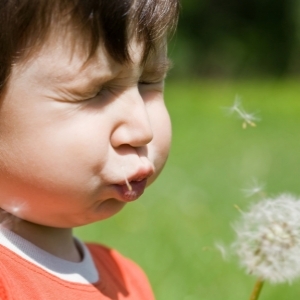
- Alternately stretch the lips, as if blowing out the fire, after stretching them in a smile. Hold the lips in the elongated state for 30 seconds, then take on the air and inflate the cheeks, lips tightly compressed. Press his fists against his cheeks, trying to remove the air without unclipping his lips.
- Squeezing the lips, distil the mass of air under the upper lip from under the bottom.
- Strongly compress lips with a strip of cardboard and keep it from 1 minute at the beginning to 50 minutes at the end.
- Blow on light objects, watching their movement.
- With little fingers, carefully stretch the corners of the mouth, then close your lips.
- We put soft rollers under the lips( bottom and top) and with tightly compressed lips try to pronounce the sounds: m, p, b.
Exercises for correcting various types of occlusion
The myogym test complex offers various exercises for various types of occlusion disorders.
Correct the mesial bite:
- with the tongue we press on the maxillary surface above the upper teeth until the sensation of fatigue appears( 4-5 minutes);
- tilting his head back, open and close his mouth, when closing we touch the tongue to the palate;
- the lower lip is drawn under the upper teeth.
Correction of oblique occlusion:
 Often oblique bite occurs as a result of a shift of the mandible to the side. In this case, such an exercise is recommended.
Often oblique bite occurs as a result of a shift of the mandible to the side. In this case, such an exercise is recommended.
With the maximum open mouth, the lower jaw is shifted in the direction of improper closure of the teeth( lower teeth are extended in front of the upper jaw).Then lift the lower jaw, close the teeth and hold in this state for 5 seconds, after which we lower it.
Correct deep bite:
- standing upright, lift the chin, and move the hands back, while the lower jaw moves as far as possible forward, and then gently return it to the place( repeat movements 10-15 times with a frequency of 3 times a day);
- after the month the task is complicated, determining the position of the lower teeth beyond the upper ones.
Myogymnastic complex for open bite:
- we squeeze and unclench teeth to the sensation of fatigue in the masticatory muscle, we control the intensity of muscular tension with the fingers pressed to the cheeks;
- the previous task is performed with considerable stress, preventing the index and middle fingers from moving the lower jaw.
How to increase the efficiency and effectiveness of the exercises
To achieve the optimal result from the exercises you need to follow several rules:
- constantly increase the intensity of training - the speed and duration of muscle contractions should increase;
- achieve the greatest amplitude of muscle contraction;
- focus the duration of employment on the appearance of a feeling of fatigue;
- withstand pauses between muscle contractions;
- for training to allocate certain time and strictly follow the established mode.
Practical experience of using
In accordance with numerous reviews, it can be said that myogymnia is especially effective for children under 7 years old. She is a good help in speech therapy. At this age, myoterapia will be an excellent alternative to other orthodontic procedures. Children in a fairly short time can fix the bite.
Our 4-year-old child did not have strong immunity, often caught cold, which prevented him from breathing through his nose. Then we noticed the appearance of some changes in his appearance.
The orthodontist confirmed our fears - oral breathing slowed the formation of jaw bones.4 months, we regularly mastered a specially selected set of exercises and received a result, to which, frankly, and did not expect.
Olga M, 33
When examined by a specialist Varenka was diagnosed - infantile swallowing, which is associated with an incorrectly formed bite. Specially selected exercises helped to solve a serious problem in less than six months without the use of special devices for wearing in the mouth. They did not even think that myogymnia is so effective.
Irina K, 28
At the same time, many adults note a low performance from such activities. 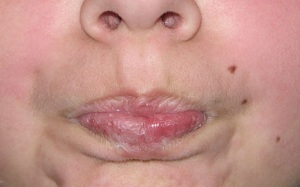
You can start the exercises only after consulting with specialists and under their constant supervision. It is the doctor who conducts the examination and selects the necessary complex of gymnastic training to eliminate the revealed defect.
The independent choice of exercises and their carrying out can not only not bring advantage, but also harm.
